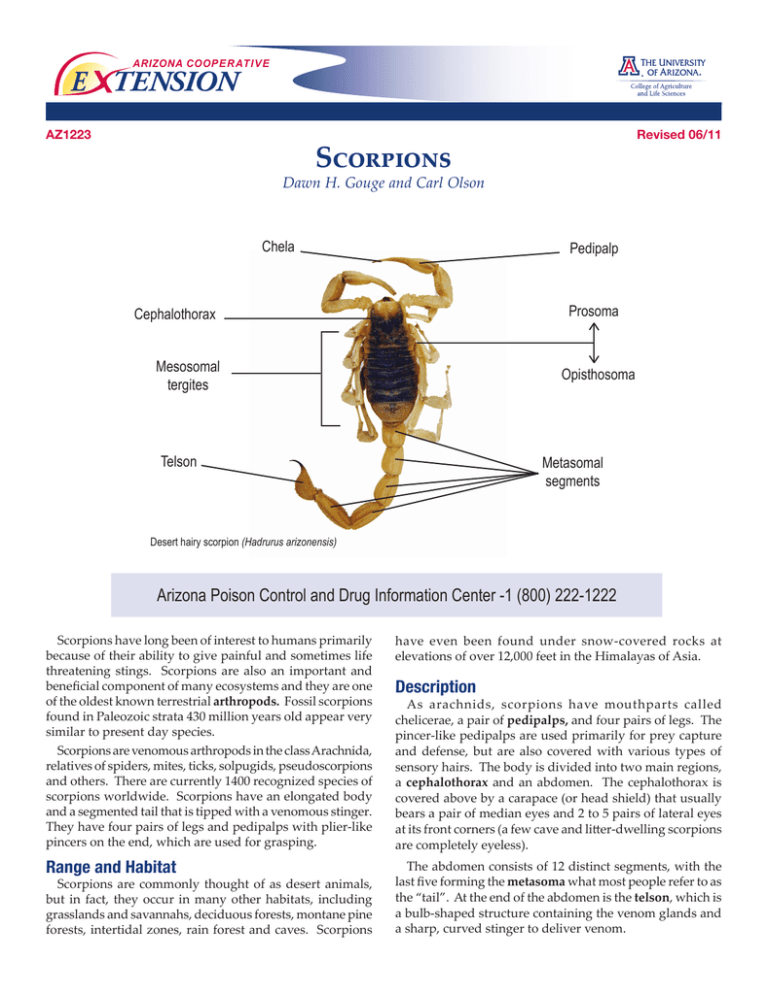Scorpions E TENSION
advertisement

ARIZONA COOP E R AT I V E E TENSION AZ1223 Revised 06/11 Scorpions Dawn H. Gouge and Carl Olson Chela Pedipalp Prosoma Cephalothorax Mesosomal tergites Opisthosoma Telson Metasomal segments Desert hairy scorpion (Hadrurus arizonensis) Arizona Poison Control and Drug Information Center -1 (800) 222-1222 Scorpions have long been of interest to humans primarily because of their ability to give painful and sometimes life threatening stings. Scorpions are also an important and beneficial component of many ecosystems and they are one of the oldest known terrestrial arthropods. Fossil scorpions found in Paleozoic strata 430 million years old appear very similar to present day species. Scorpions are venomous arthropods in the class Arachnida, relatives of spiders, mites, ticks, solpugids, pseudoscorpions and others. There are currently 1400 recognized species of scorpions worldwide. Scorpions have an elongated body and a segmented tail that is tipped with a venomous stinger. They have four pairs of legs and pedipalps with plier-like pincers on the end, which are used for grasping. have even been found under snow-covered rocks at elevations of over 12,000 feet in the Himalayas of Asia. Range and Habitat The abdomen consists of 12 distinct segments, with the last five forming the metasoma what most people refer to as the “tail”. At the end of the abdomen is the telson, which is a bulb-shaped structure containing the venom glands and a sharp, curved stinger to deliver venom. Scorpions are commonly thought of as desert animals, but in fact, they occur in many other habitats, including grasslands and savannahs, deciduous forests, montane pine forests, intertidal zones, rain forest and caves. Scorpions Description As arachnids, scorpions have mouthparts called chelicerae, a pair of pedipalps, and four pairs of legs. The pincer-like pedipalps are used primarily for prey capture and defense, but are also covered with various types of sensory hairs. The body is divided into two main regions, a cephalothorax and an abdomen. The cephalothorax is covered above by a carapace (or head shield) that usually bears a pair of median eyes and 2 to 5 pairs of lateral eyes at its front corners (a few cave and litter-dwelling scorpions are completely eyeless). On its underside, the scorpion bears a pair of unique comb-like sense organs called the pectines; these are usually larger and bear more teeth in the male and are used to sense the texture and vibration of surfaces. They also serve as chemoreceptors (chemical sensors) to detect pheromones (communication chemicals). The “long-tailed” African Scorpion (Hadogenes troglodytes) reaches a length of over 8 inches, and is probably the longest scorpion in the world. Some of the African and Asian Emperor Scorpions routinely reach (and probably exceed) 7 inches. The largest scorpions in the United States are members of the genus Hadrurus (giant desert hairy scorpions), obtaining a length of about 5 inches. Giant desert hairy scorpions also occur in Arizona. Behavior Scorpions are nocturnal or diurnal, predatory animals that feed on a variety of insects, spiders, centipedes, and other scorpions. The larger scorpions occasionally feed on vertebrates, such as small lizards, snakes, and mice. Prey is detected primarily by sensing vibrations with the pectine organs. The pedipalps have an array of fine sensory hairs that sense air-borne vibrations; the tips of the legs have small organs that detect vibrations in the ground. Most scorpions are ambush predators who detect prey when it comes within reach. each night. They may enter homes and buildings when their territory has been disrupted by construction, tree removal, irrigation, or floods, etc. Scorpions have many adaptations for desert living. They have extra layers of lipids (fats) on their exoskeleton (external skeleton) that minimizes water loss. Most are active at night, and spend their days where it is cool and moist under rocks, wood, tree bark or in burrows. Although scorpions can be seen drinking directly from water reservoirs, they derive most of their water from their food (although this varies by species). As with most arthropods their activity is linked to temperature. Generally speaking, scorpions are active if nighttime temperatures are above 70°F. They tend to be less active during winter and the hottest part of the summer during daylight hours. Life Cycle Scorpions have a complex mating ritual in which the male uses his pedipalps to grasp the female’s pedipalps. The male then leads her in a “courtship dance”. The details of courtship vary from species to species, with some even exhibiting a deliberate and prolonged “sexual sting” by the male. The sperm from the male is contained within a structure called a spermatophore, which is deposited by the male on a surface over which the female is pulled. The male sweeps his pectines over the ground surface to help locate a suitable place to deposit his spermatophore. The female draws the sperm into her genital pore, which is located near the front ventral (under) side of her abdomen. Scorpions have a long gestation period (from several months to over a year, depending on species) in which the young develop as embryos in the female ovariuterus or in specialized diverticula that branch from the ovariuterus. The young are born live and ascend their mother’s back. She assists them by making a “birth basket” with her folded legs to catch them as they are born and to help them climb onto her back. A few Old World species do not form birth baskets. Bark scorpion eating cricket. The surfaces of the legs, pedipalps, and body are also covered with thicker hairs (setae) that are sensitive to direct touch. Although they are equipped with venom for defense and prey acquisition, scorpions themselves fall prey to many types of creatures, such as centipedes, tarantulas, insectivorous lizards, snakes, birds (especially owls), and mammals (including shrews, grasshopper mice, and bats). As with many predators, scorpions tend to forage in distinct and separate territories, returning to the same area 2 The University of Arizona Cooperative Extension Female bark scorpion (Centruroides sculpturatus) with young on her back readily available. Some studies suggest typical mortality rates up to about 4% in hospital cases, with children and the elderly being most susceptible. Death by scorpion sting, if it occurs, is the result of heart or respiratory failure some hours after the incident. During the 1980’s Mexico averaged about 800 deaths each year. However, in the past 20 years there have been no reported fatalities in the U.S. due to scorpion stings. Scorpions in Arizona About 40-60 species occur in Arizona, although many are undescribed. The bark scorpion (Centruroides sculpturatus) is the only species in Arizona of medical importance. Female scorpion with young on her back On average, a female gives birth to about 25-35 young. They remain on her back until they molt for the first time. The white colored young have been seen to climb down off the mothers back, molt then return to the mothers back for another 4-5 day before leaving for good, usually within one to three weeks after birth. Once they climb down, they assume an independent existence, and periodically molt to reach adulthood. Typically five or six molts over two to six years are required for the scorpion to reach maturity. Immature scorpions often climb onto the backs of adult females where they are tolerated. The average scorpion probably lives three to five years, but some species may live up to 25 years. A few scorpions exhibit social behaviors beyond the mother-young association, such as forming over-wintering aggregations, colonial burrowing, and even living in extended family groups that share burrows and food. Scorpion Venom The venom of scorpions is used for both prey capture, defense and possibly to subdue mates. All scorpions do possess venom and can sting, but their natural tendencies are to hide and escape. Scorpions can control the venom flow, so some sting incidents are venomless or only mild envenomations. Scorpion venoms are complex mixtures of neurotoxins (toxins which affect the nervous system) and other substances; each species has a unique mixture. Despite their bad reputation, only one species in the western U.S. (the bark scorpion, Centruroides sculpturatus) and about 25 others worldwide have venom potent enough to be considered dangerous to humans. The most dangerous scorpions in the world live in North Africa and the Middle East (species in the genera Androctonus, Buthus, Hottentotta, Leiurus), South America (Tityus), India (Mesobuthus), and Mexico (Centruroides). In some of these areas, scorpion stings may be a significant cause of death, but reliable data on human mortality are not Arizona bark scorpion (Centruroides sculpturatus) In the U.S. the bark scorpion is found in southeastern California, Arizona, Nevada, southern Utah, and southwestern New Mexico. Small populations have been found in northern California and the state of Colorado. It is also found throughout the Baja Peninsula and western Sonora in Mexico. The typical “bark” or “crevice” scorpion is encountered in a variety of situations. It is most commonly found under rocks, logs, tree bark, and other surface objects. The bark scorpion (1-3 inches in length) is the most commonly encountered house scorpion. They are common throughout many habitats but almost always in rocky areas. Most scorpion species are solitary in nature. The exception to this is bark scorpions, which may over-winter in aggregates of 20-30. The bark scorpion is also one of relatively few species that are able climbers. They can climb vertical walls, but do not make it far across a horizontal ceiling. Bark scorpions may cluster together in groups The University of Arizona Cooperative Extension 3 The stripe-tailed scorpion is typically found under many surface objects (including sleeping bags, shoes, etc.) where it digs a short burrow or “scrape” for protection. This species is normally an obligate burrower, digging burrows about one meter deep in gravel soils. Stings are usually not medically significant and less painful than a honey bee sting. The venom of the bark scorpion may produce severe pain (but rarely swelling) at the site of the sting, numbness, frothing at the mouth, difficulties in breathing (including respiratory paralysis), muscle twitching, and convulsions. Death is rare, especially in more recent times. Antivenin is available for severe cases in some hospitals. Envenomation of children (under 9 years of age) or people with hypertension should be considered serious and immediate medical help sought (911). Certain people, however, may be allergic to the venom and can experience life-threatening side effects when stung (as occurs with bee stings). No cases of anaphylaxis have been reported in Arizona. Management of Scorpions High numbers of scorpions can become a problem under some circumstances. Pest-proofing of the home is an essential first step. If a reduced population is desirable several steps can be taken. Another species found in Arizona is the desert hairy scorpion (Hadrurus arizonensis). This species is twice as large as the bark scorpion at maturity (up to 5 inches long). They are often found in low sandy areas throughout the state. Scorpions are almost impossible to manage with insecticides alone. Therefore, the first control strategy is to modify the area surrounding a house or structure: • Conduct U.V. black-light collections several times during the summer between 8-11pm. • Remove all harborages such as: trash, logs, boards, stones, bricks and other objects from around the building. • Keep grass closely mowed near the home. Prune bushes and overhanging tree branches away from the structure. Tree branches can provide a path to the roof for scorpions. Minimize low growing ground cover vegetation. • Store garbage containers in a frame that allows them to rest above ground level. • Never bring firewood inside the building unless it is placed directly on the fire. • Install weather-stripping around loose fitting doors and windows. • Ensure door sweeps are tight fitting Desert Hairy Scorpion (Hadrurus arizonensis) Desert hairy scorpions usually eat insects, spiders, centipedes, small vertebrates and other scorpions. Kristen Clason Another genus frequently found is the devil or stripetailed scorpion group (Vaejovis spp.). There are several Vaejovid species found in Arizona. They are intermediate in size (1-2 inches in length) and are more robust than bark scorpions. Bark scorpion entering under a doorway Stripe-tailed scorpion (Vaejovis spinigeris) 4 The University of Arizona Cooperative Extension • Plug weep holes in brick veneer with steel wool, pieces of nylon scouring pad or small squares of screen wire. • Caulk around roof eaves, pipes and any other cracks into the building. • Keep window screens in good repair. Make sure they fit tightly in the window frame. • Stucco cinder-block walls. Black-lighting Scorpions fluoresce or glow under ultraviolet light so they are easy to find with the aid of a black-light during the night. Nighttime scorpion hunting is a lot of fun but make sure that you wear boots and have long tongs if you want to capture the scorpions to move them. Scorpion-like Creatures Besides true scorpions, there are a number of other arachnids that look similar and at first glance may be confused with scorpions. Powerful black-lights can be ordered from the internet or weaker ones can be obtained from pet stores and electronic retailers. Once located, collect the scorpions using long forceps and keep them in a sealable, sturdy container. As these wonderful creatures are such a benefit to our environment please consider collecting and releasing the scorpions into the natural desert rather than killing them. Pseudoscorpion Pseudoscorpions are arachnids with a body length of approximately ⅛th inch. The pedipalps give them a strong resemblance to true scorpions. Natural habitats for pseudoscorpions include under leaf litter and mulch, in moss, under stones and beneath tree bark. They have also been reported in bird nests and between siding boards of buildings. Pseudoscorpions are predaceous and can inflict a venomous bite. Alex Yelich Chemical pesticide spraying during the day is largely ineffective. Alex Yelich Never look directly at an ultraviolet light, damage to the eye may occur. Solpugid, sun spider or windscorpion Alex Yelich Desert Hairy Scorpion under a U.V. light Solpugid Desert Hairy Scorpion under day-light Solpugids are pale-tan arachnids. The body can be up to an inch and a half in length, with a pair of heavy pinchers dominating the front end. They have four pairs of long legs and pedipalps in front that are used in touching and smelling. They run fast and climb well. Solpugids subdue their prey with their pinchers, which lack poison glands. The University of Arizona Cooperative Extension 5 Tips for Professionals Daytime spraying is largely ineffective. The most effective scorpion management method is nighttime blacklight collecting. The authors wish to thank Dr. Christopher Baptista (Arizona Department of Agriculture), Dr. Bob Smith (Department of Entomology, University of Arizona) and George Bradley Herpetological Curator, University of Arizona), for editing this extension publication. Whipscorpion or vinegaroon Whipscorpions are found in the southeastern oak zone of Arizona eastwards across the southern U.S. to Florida. They have a substantial but flat body 2-3 inches in length, with large spined, arm-like pedipalps in front. They are arachnids, but have no venom. Whipscorpions are predators, active at night. The whip-like tail is used in defense and individuals can squirt acetic acid (vinegar) produced from a gland in the rear. ARIZONA COOP E R AT I V E E TENSION THE UNIVERSITY OF ARIZONA Tailless whipscorpion The front of this animal is similar to the whipscorpion, with heavily spined, grasping arms. They also have a pair of very long and limber front legs, which are used to touch and smell. Tailless whipscorpions are dark brown in color and the width across it’s very flattened body can exceed an inch. They are predators, but have no venom. Pseudoscorpions, solpugids, whipscorpions and tailless whipscorpions do not sting like scorpions, control is unnecessary and they provide excellent control of cockroaches. Do not intentionally handle them as they are delicate creatures. COLLEGE OF AGRICULTURE AND LIFE SCIENCES The University of Arizona College of Agriculture and Life Sciences Tucson, Arizona 85721 Dawn H. Gouge Associate Professor and Associate Specialist - Urban Entomology Carl Olson Associate Curator, Insects Contact: Dawn H. Gouge dhgouge@ag.arizona.edu This information has been reviewed by University faculty. cals.arizona.edu/pubs/insects/az1223.pdf Originally published: 2001 Other titles from Arizona Cooperative Extension can be found at: cals.arizona.edu/pubs Any products, services or organizations that are mentioned, shown or indirectly implied in this publication do not imply endorsement by The University of Arizona. Issued in furtherance of Cooperative Extension work, acts of May 8 and June 30, 1914, in cooperation with the U.S. Department of Agriculture, Kirk A. Astroth, Interim Director, Cooperative Extension, College of Agriculture Life Sciences, The University of Arizona. The University of Arizona is an equal opportunity, affirmative action institution. The University does not discriminate on the basis of race, color, religion, sex, national origin, age, disability, veteran status, or sexual orientation in its programs and activities. 6 The University of Arizona Cooperative Extension







